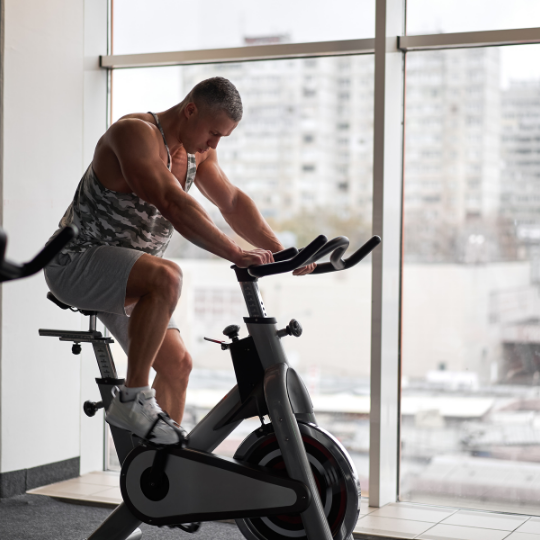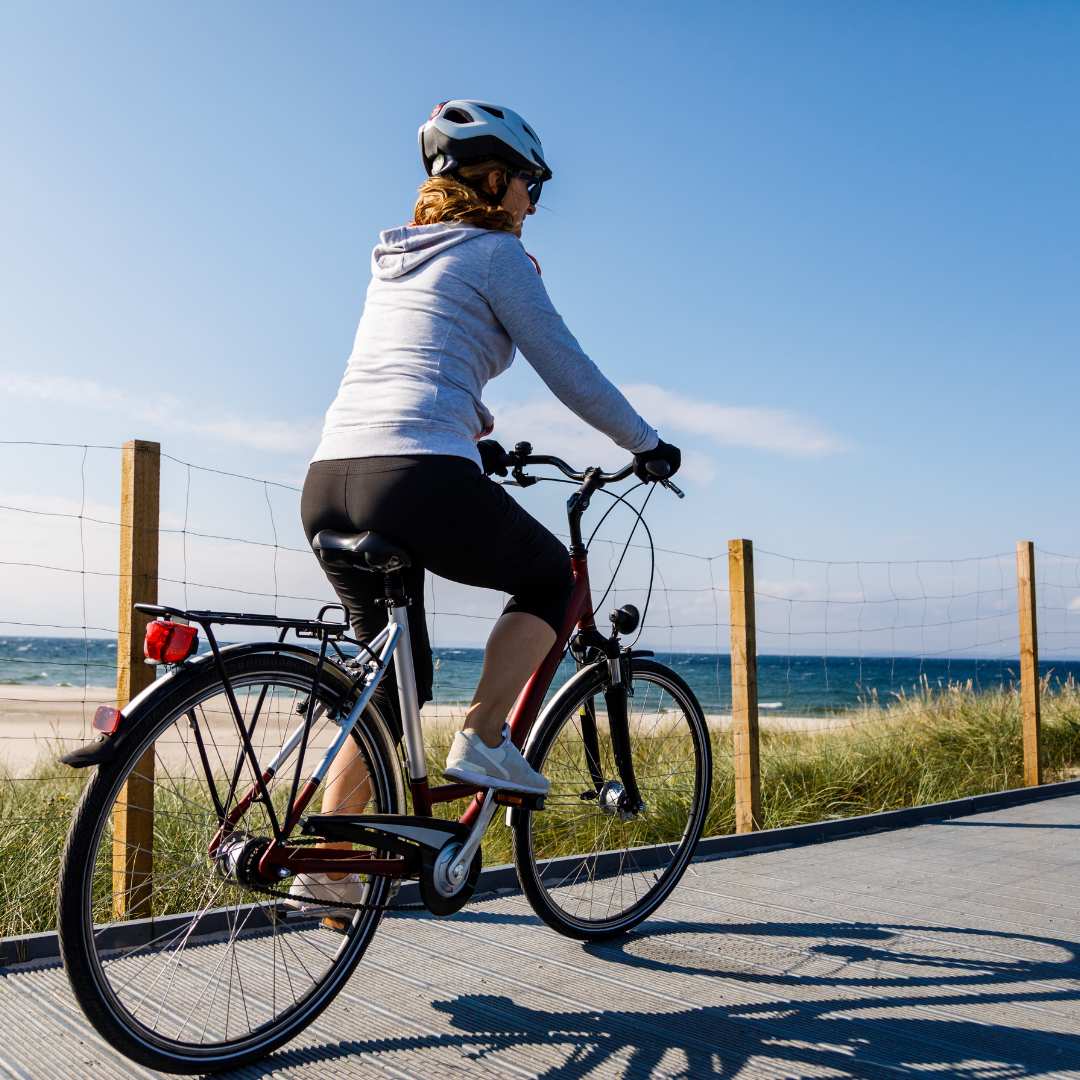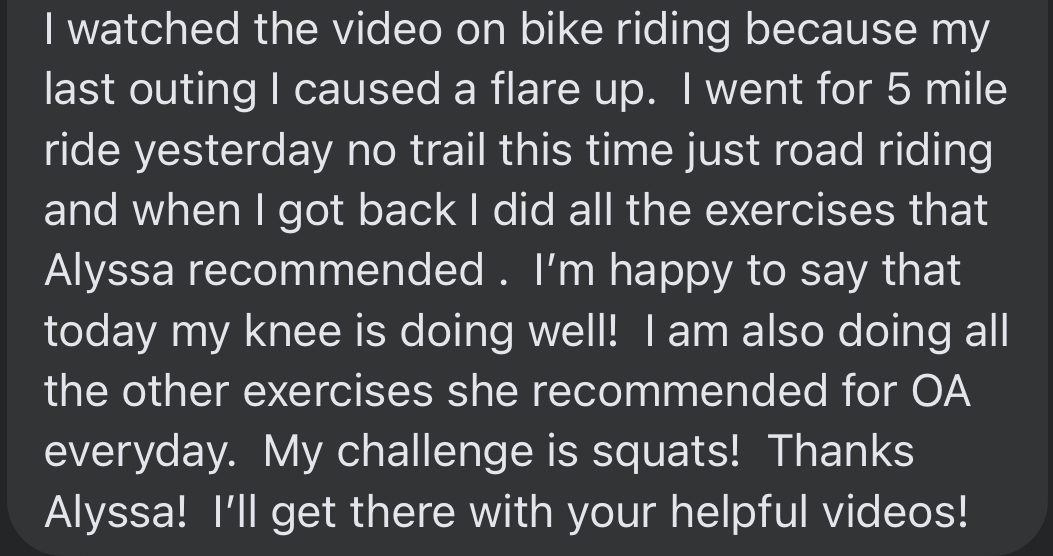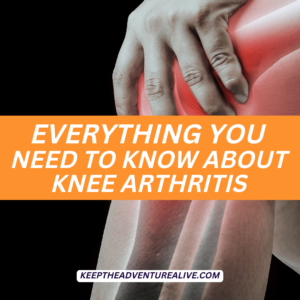You may have heard you can cycle for knee pain relief but are you afraid of making your knee pain worse? You may have been told a recumbent exercise bike is best…but is it? There are a few mistakes people commonly make that you need to consider before hopping on a bike or a cycling exercise machine. This includes finding the right cycling set up for you, adding variety, and looking at intensity. If you fall victim to some of these mistakes, you may be making your knee more angry. Here’s what you need to know!
This article contains affiliate links that provide me a small compensation if a product is purchased through the link. This is at no extra cost to you.
Is cycling good for knee arthritis?
Figuring out the best type of exercise when dealing with knee osteoarthritis can be tricky. If you are new to a knee osteoarthritis diagnosis, here is a post on everything you need to know.
This article is for you if:
- You have difficulty with range of motion (i.e bending and straightening) your knee because of pain and/or stiffness
- You are having a hard time finding exercise that doesn’t flare up your chronic knee pain
- You want to strengthen your knees in a safe way
- You love cycling and want to make sure you aren’t making any mistakes especially with knee osteoarthritis
If you are attempting to cycle for knee pain relief, it is imperative you understand a few things so you don’t end up making your knee angrier in the process.
Cycling is typically lower impact so it is usually suggested if you have chronic knee pain and/or knee osteoarthritis because it can help with many different things. Cycling can help you to improve knee range of motion, decrease knee stiffness, improve knee strength and stamina.
But it’s important to make sure you are picking the right cycling set up and type of machine for you to help relieve your knee pain. Below you will find common mistakes people typically make that could actually increase knee pain. We will discuss the different types of bikes which include:
- recumbent exercise bike
- upright bike
- outdoor bike
Before reading further, this video will help to explain the general benefits cycling has for knee pain and knee osteoarthritis.
Mistake #1: The wrong cycling type
There are different kinds of bikes you can use to cycle for knee pain relief. The perfect type for you will depend on a couple of things. I am going to list the common types and who they may be appropriate for:
Recumbent exercise bike

A recumbent bike allows you to be in a semi-reclined position compared to upright which we will talk about in the next section. You may have used this bike if you have attended physical therapy for your knee pain or following a knee replacement.
These bikes may not be for everyone though…A common question I get is “Are recumbent exercise bikes good for the knees?” Let’s answer that below with some common scenarios in which a recumbent bike will likely help your knees.
Helps accompanying back, wrist and/or shoulder pain. I like this bike choice if you are also dealing with pain in other joints including back, shoulder, and wrists or other conditions such as spinal stenosis. When riding an upright bicycle (in the next section) you tend to place more pressure on these joints due to the lack of support.
The seat on the recumbent exercise bike allows you to work your knees without stressing other joints that may be impacted by osteoarthritis.
Nicer to the knees. If you are dealing with knee pain or stiffness that is impairing your range of motion, the recumbent exercise bike can be a great way to begin exercising. It doesn’t require as much bending compared to an upright bike and can feel nicer to the knees.
You do want to make sure the range of motion required for the recumbent bike feels comfortable to you. If you feel like you are forcing your knee through the range of motion, it may be too intense. You can reduce the resistance while seeing if stiffness decreases with more revolutions.
If it sounds like you would be perfect for a recumbent exercise bike, you can find one HERE.
Upright bike (SPIN BIKE)

An upright bike lacks the back support of the recumbent exercise bike and can place more pressure on your upper body. It also requires more core control and stability. This can increase the intensity of the workout but can also irritate other joints if your osteoarthritis has spread.
More challenging. If you are more advanced in your training or if you are training for outdoor cycling, this upright bike may be more appropriate for you.
It is also more challenging to your knee range of motion. The mean range of motion has been found to be at a max of 112 degrees of bending. If you have a hard time bending your knee past about 90 degrees, you may have difficulty with this position.
If you are forcing bending when you are trying to cycle for knee pain, you may actually increase your knee pain if your knee is not ready for it.
If it sounds like you would be perfect for an upright, stationary bike, this was ranked one of the best from Bikes Reviewed, you can find it HERE.
Outdoor bike

An outdoor bike resembles the set up of an upright bike in the previous section. As above, this setup requires deeper knee bend and more stability. Many people with knee pain may not have the adequate balance to start on an outdoor bike.
If you are lacking knee bending range of motion or do not feel comfortable in your balance, this setup may not be the most appropriate to start with. A recumbent exercise bike may be a better choice initially.
One thing I do recommend to those looking to go outdoors to cycle for knee pain is to try in a bike trainer first or on an upright bike to make sure you feel comfortable in this position.
It is possible to work up to riding a bike outdoors again once you feel more comfortable and your knee range of motion increases.
Mistake #2: lack of variety
If cycling doesn’t feel great on your knees right now, lack of variety could be why. Just simply adding in a few other exercises before or after you ride can be really powerful. Take a look below:

Cycling is a repetitive motion in a circular direction. You are repeating the same motion over and over again, no matter which type of bike you are on.
This can be a problem with knee osteoarthritis because stressing the same part of the knee joint can actually increase your pain, especially if you are potentially overdoing it.
It is so important that you introduce variety into your training. This includes movements that require you to move side to side and/or backwards. These movements can simply be added before or after you ride.
For example, walking backwards can be very powerful at helping relieve knee pain. Simple side stepping or lateral kicks can also help to keep your knee joint happier.
If you are using cycling as your only form of exercise while trying to tackle arthritis pain relief, it may not be a fool-proof method.
Now you may experience less stiffness and less pain but you could unlock so much more potential if you added simple variety into your training.
If you would like more ideas on how to add variety to your training- you can get started on my 4 day challenge that includes 4 days of arthritis friendly workouts including many different exercises that are safe for your joints. You can learn more about it below.
Mistake #3: overdoing it
When you experience pain, stiffness, or swelling after an activity- it is likely your joint telling you “hey that was too much!” I get asked all the time how you would know if you have done too much or if it was just the right amount of activity.
When trying to cycle for knee pain, a common scenario is thinking more is better (i.e trying to ride for longer time or distance). But if you are dealing with pain, particularly arthritis pain- more is not always better when it comes to activity.
The idea is making sure you are including variety like mentioned above, but also making sure not to overdo it. How do you know if you’ve overdone it? Check out this video below for tips.
It is important to find a balance when it comes to what feels just right to your knees. You don’t want to push through significant pain as it likely will leave you feeling worse than when you started.
When trying to cycle for knee pain relief, you can likely modify both the resistance and the length of time you use the bike for. If you notice more pain, stiffness, or swelling after- try changing one of those variables.
If you begin to feel pain or swelling after 15 minutes on a level 5 resistance- try to reduce the time to 10 minutes or reduce the resistance level by 2-3 notches. Playing with these different variables can help make cycling for your knee pain much more enjoyable.
The best way to cycle for knee pain
Making sure you have the right cycling setup, added variety, and appropriate activity levels are all key when trying to reduce knee osteoarthritis or chronic knee pain.
These are common mistakes I see so many people making and I don’t want you to be next! Share this article with anyone who you know who is looking to try to cycle with knee pain.
I have commonly found that cycling on its own, is likely not enough to produce long lasting pain relief, especially from knee osteoarthritis.
No matter where you are at on the scale of knee osteoarthritis, from mild to bone on bone, pain relief is absolutely possible.
There have been people who have been told they needed a joint replacement who have been able to find life changing pain relief to the point they are climbing stairs with ease, walking without pain, and sleeping through the night.
They have been able to accomplish these amazing feats when no one else believed in them, sometimes even their doctors doubted them! Adventures and dreams have been made possible by my signature course, the Arthritis Adventure Blueprint.
Don’t sell yourself short just because you have osteoarthritis and/or chronic knee pain. Learn more about the course by clicking the button below!

The Arthritis Adventure Blueprint
Dr. Alyssa Kuhn’s signature program to help you avoid surgery, reignite your adventures, and even do things you never thought you would do again.
You will learn the secrets to osteoarthritis pain relief that actually work- including exercise, diet, and other ways to control inflammation! Say goodbye to short term pain relief, it’s time to make it last.
Alyssa Kuhn
This post is for general informational purposes only. It should not be used to self-diagnose and it is not a substitute for a medical exam, cure, treatment, diagnosis, and prescription or recommendation. It does not create a doctor-patient relationship between Dr. Kuhn and you. You should not make any change in your health regimen or diet before first consulting a physician and obtaining a medical exam, diagnosis, and recommendation. Move Well Age Well, LLC and Dr. Alyssa Kuhn, PT, DPT are not liable or responsible for any advice, course of treatment, diagnosis or any conclusions drawn, services or product you obtain through this video or site.




